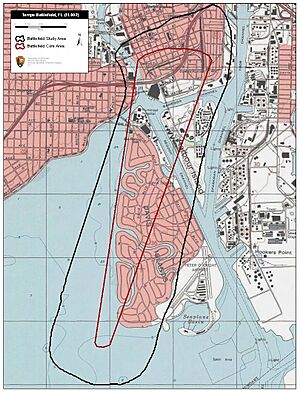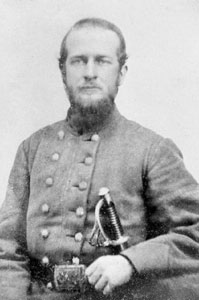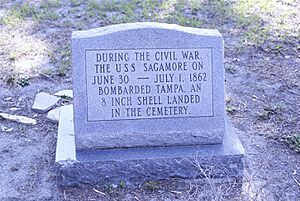Battle of Tampa facts for kids
Quick facts for kids Battle of Tampa |
|||||||
|---|---|---|---|---|---|---|---|
| Part of American Civil War | |||||||
|
|||||||
| Belligerents | |||||||
| Commanders and leaders | |||||||
| A.J. Drake | John William Pearson | ||||||
| Units involved | |||||||
| U.S.S. Sagamore | Osceola Rangers | ||||||
| Strength | |||||||
| 1 gunboat | 1 company | ||||||
| Casualties and losses | |||||||
| 0 | 0 | ||||||
The Battle of Tampa was a small fight during the American Civil War. It happened from June 30 to July 1, 1862. The battle was between the United States Navy and a group of Confederate soldiers. These soldiers were protecting the town of Tampa, Florida.
Even though Tampa was a small town, its port was very important for trade in Central Florida. Many ships called "blockade runners" used this port. These ships would try to sneak past the Union naval blockade. This blockade was set up by the Union Navy to stop trade along the Atlantic and Florida's west coast.
On June 30, 1862, a Union warship called the USS Sagamore sailed into Tampa Bay. Its commander demanded that the small Confederate fort, Fort Brooke, surrender. But Captain John William Pearson, who led the Confederates, refused. Captain A.J. Drake of the Sagamore then warned that his ship would start firing at 6:00 PM.
The Sagamore began shooting at the fort and town from far away. Fort Brooke fired back with its three large cannons. Neither side caused much damage or had any soldiers hurt. The next morning, the Sagamore fired a few more shots from a safe distance. Then, it sailed back to its blockade station near the mouth of Tampa Bay.
Later, there were bigger Union attacks on Tampa. In October 1862, during the Battle of Fort Brooke, several blockade runners were destroyed. Union forces also briefly took over Fort Brooke in May 1864.
Why Tampa Was Important
In April 1862, a Union ship appeared near Tampa. Confederate soldiers were worried it was a trick. They thought Union troops might try to land elsewhere and attack from behind. A Union officer demanded that Tampa surrender. But Major Thomas, a Confederate leader, bravely refused. He told the Union officer that they "did not understand the meaning of the word surrender."
The Union officer then gave them 24 hours to get women and children out of town. He said they would attack after that time. The Confederate soldiers cheered, showing they were ready to fight. They were told to move their belongings up the river in case they had to retreat.
By the summer of 1862, the Union planned to make their blockade even stronger. They wanted to capture important ports like New Orleans and towns along the Mississippi River. Union leaders knew that if they could stop all trade, the Confederates would run out of supplies. This would force them to surrender, as they needed goods from other places to keep fighting the war.
The Battle Begins
On June 30, the USS Sagamore sailed into Tampa Bay. It turned its side towards the town, ready to fire its cannons. A small boat with 20 Union soldiers, carrying a white flag of truce, headed towards shore.
Captain John William Pearson of the Confederate Army quickly sent 18 of his men in a boat to meet them. He wanted to make sure the Union soldiers did not land. When they met, the Union lieutenant demanded that Tampa surrender completely.
Captain Pearson told him, "We did not understand the meaning of the word surrender; there was no such letter in our book; we don’t surrender." The Union officer then said they would start shelling the town at 6:00 PM. Captain Pearson replied, "pitch in!" His men then cheered loudly for the Southern Confederacy.
At 6:00 PM, the Sagamore began firing large shells and shots. After two shots from the Union ship, the Confederates fired back with their three 24-pounder cannons. Both sides kept firing until 7:00 PM. At that point, the Sagamore pulled back.
On July 1, the Sagamore fired again from 10:00 AM to 12:00 PM. This time, it stayed too far away for the Confederate cannons to reach. After a two-hour break, the Sagamore fired two more shots, then raised its anchor and sailed away. No Confederate soldiers were hurt in the battle. Captain Pearson praised Captain James Gettis for his strong leadership during the fight.
What Happened Next
The Battle of Fort Brooke was a more important fight that happened in Tampa a few months later, in October. In that battle, a Union warship again fired at Fort Brooke. But this time, a small Union raiding group secretly landed. They found and destroyed several Confederate blockade runners hidden up the Hillsborough River before leaving.
Union forces came back to Tampa one more time in May 1864. By then, the Confederate war effort was struggling. Many of Fort Brooke's defenders had been sent to other, more urgent places. Troops from the USS Adela landed in Tampa without any resistance. They destroyed or took any remaining supplies at Fort Brooke, which was empty. After two days, they left town.
Two cannons from Fort Brooke were thrown into the Hillsborough River during this raid. They were later found and fixed. Today, you can see them on display in Plant Park, on the University of Tampa campus.
Images for kids







